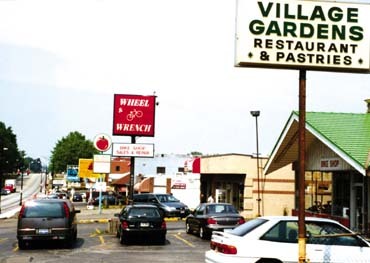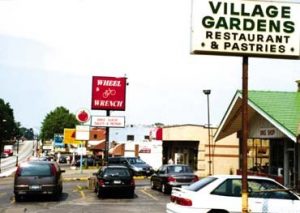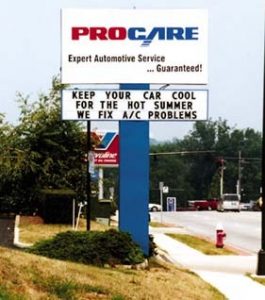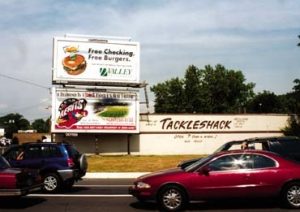Business Management
Newton’s Law and Sign Control
Actions and political reactions can cause problems for sign companies.
Published
18 years agoon

Easy-going, local sign regulations can certainly simplify life and stimulate business for sign companies and end users alike. Understandably, many in the sign industry favor them. But, permissive sign codes can eventually bite back.
Just recall that physics teacher who drove you nuts in high school, intoning that, according to Newton’s Third Law of Motion, for every action, there’s an equal, but opposite, reaction. Then consider that, when local sign rules are too loose, and sign users act accordingly, the eventual political reaction can jeopardize reasonable sign-control policy. That happened in Cuyahoga Falls, an older suburb of Akron, OH.
The Falls’ 1970s zoning quite permissively allowed signs and billboards in large areas of the city. Both on-premise signshops and the local outdoor company — Clear Channel Outdoor (Parma, OH) — understandably built what zoning said city officials could completely allow.
The result, undeniably, caused visual problems, especially along State Rd., a busy, but aging, business center with many dated-looking signs past due for replacement. A Newtonian reaction to the old zoning rules was probably inevitable.
Choosing flexibility
An initial order of business for the Falls’ new planning director, Fred R. Guerra, therefore, was to create a new sign code. Despite the permissive regulations, city hall planners’ sign-control activities had, for years, been quite controversial in the business community, particularly among the many local car dealers.
Guerra coupled the sign-code work with an all-new development code to be prepared with consulting assistance. Proposals from numerous consultants resulted in their hiring my firm, Gann Associates, which is nationally known, both among municipal officials and in the sign industry, for sign-control work.
My ‘win-win regulation’ approach calls for appointing a diverse, public-private advisory committee to oversee step-by-step development of new provisions. The 19-member Falls group included representatives from various city-government departments, citizen activists and the business community.
To supplement the committee’s monthly meetings, the planning director and I also met regularly with key stakeholders — the chamber of commerce, local car dealers, and David Yale and Scott Rowland of Clear Channel. The outdoor company owns 51 boards (mostly 30-sheets) that had become controversial in the city.
Guerra previously had both commissioned sign-code development and agreed to solicit active sign-industry participation. I’d suggested he open the process in Barberton, OH, to the Sign Display and Allied Trades Union, AFL-CIO, Local 639. Represented by well-known industry consultant Jim Claus, the union actively participated in every advisory-committee meeting, a process that produced regulations approved by all parties (see ST, May 1995, page 233 ).
Despite this past success, in Cuyahoga Falls, Guerra backed away from such inclusiveness, insisting that the union not participate. Instead, a representative from a single on-premise signshop, Ellet Neon, was allowed on the advisory committee. Normal schedule conflicts meant, of course, that, with just one representative, no industry voice spoke at several important meetings. And despite the magnitude of Clear Channel’s community investment, Guerra denied it a seat on the committee.
The American Planning Assn., however, was allowed to contribute its sign-control ideas to the local process. Guerra distributed to committee members the entirety of APA’s controversial "best practices" manual, which was prepared with sign-industry funding. The disputed work, made available on APA’s website, but not published in print, triggered a lawsuit against APA by the Signage Foundation for Communication Excellence (see ST, August 2003, page 176).
"Cafeteria-style" regulations
The advisory committee nonetheless represented a full range of opinions. Views ranged from laissez faire to Saving Face, Ronald Lee Fleming’s polemic against corporate architecture and signage, which was also published and promoted by APA.
Committee members quickly favored flexibility and creative freedom over regulatory micro-management. So I developed a system that gave the sign user freedom of choice while infusng incentives that reflected city policy.
We reconciled the tension between individual choice and public policy using two regulatory mechanisms: formulae and incentives. The result, dubbed "cafeteria-style" regulations by long-time planning department staffer Peter Korycan, is not your traditional sign code.
The code allows an overall amount of sign-face area for each property. The sign user determines how to allocate it among more smaller signs, or fewer larger signs. This area is computed by a formula, derived from the specs of actual city signs, and city-hall planners’ judgments as to which displays represented desirable signage models.
But my proposal also acknowledged that well-done displays can be larger without adverse visual effect on their surroundings. So the code rewards, with extra allowable sign-face area, any sign user willing to enhance displays with landscaping, pole covers, ornamental materials or other measures.
Clutter control with choice
Among planners, the word "clutter" is undoubtedy most often associated with signs. And, the worst clutterers are usually considered highway pole signs and projecting signs downtown. Planners often want to ban projecting signs and replace pole signs with low monument signs. But, either can create visibility problems for sign users and the public.
The "clutter" aspect arises because pole and projecting signs create new structures or planes in the built environment — usually positioned perpendicular to the viewer’s line of sight. Wall, awning and window signs, on the other hand, appear on existing structures, thus contributing less to perceived clutter.
With the clutter effect in mind, the new code defined all signs into just two regulatory types: surface signs and non-surface signs. Surface signs adorn walls, windows or canopies — items that aren’t signs. Non-surface signs, such as pole and projecting signs, create entirely new structures or planes. This regulatory distinction was used previously in Robinson, IL (see ST, March, 2002, page 70).
To control clutter, but allow sign users choices, the code doubles the permissible face area of non-surface signs for a property. So a 50-sq.-ft. pole sign equals a 100-sq.-ft. wall sign. The sign user chooses between them. The incentive, obviously, is for businesses to use more surface signs.
Planners consider sign height undesirably obtrusive. Sign users, of course, know it increases visibility. The code, therefore, specifies that, the taller the sign, the less sign-face area allowed. The end-user chooses the combination of height and size. The planner gets some visual control either way.
Consistent with court rulings, the code doesn’t distinguish signs based on message content. Billboards are regulated simply as large, non-surface signs.
In another departure from sign-code orthodoxy, two standards of restriction were defined to apply in different places. In a few "showcase" areas, stricter standards rule, while more relaxed requirements prevail elsewhere.
The advisory committee modified my draft’s flexibility by adding absolute ceilings on both area and height for individual signs.
SNAPs and spectaculars
When towns react to their own permissive policies with more stringent controls, nonconformities present problems. These signs were legally built, but now violate new standards.
Local activists lobbied hard to amortize nonconforming signs, even though amortization is generally prohibited by Ohio statute. And Akron-area communities that had tried it hadn’t made it work.
Amortization is designed as a form of just compensation. If a city takes property, it must pay the owner just compensation. With amortization, the theory is that, if a business is allowed to keep its nonconforming sign for a set period of time, such as three years, it will have had time to recoup its investment. This would presumably qualify as just compensation. So, the city wouldn’t be required to pay any cash compensation.
However, the proposed sign-area cap made all billboards in the city nonconforming. So, Clear Channel promised litigation if the city enacted amortization. As an alternative, I proposed Sign Nonconformity Action Plans (SNAPs).
A SNAP, negotiated between the city and the sign user, is designed to remediate any adverse effects of nonconforming signs, rather than to eliminate them. The intent is substantial improvement in a difficult situation, rather than perfect compliance with new, after-the-fact zoning rules. The end result, for example, might be landscaping around the base of a sign rather than removing it. Both the city and the sign user must agree to the SNAP, so quid pro quo (an equal exchange or substitution) becomes the rule.
The code allows a city SNAP committee to require things the code doesn’t normally mandate, and allow things the rules don’t otherwise permit. The face area of existing signs that exceed the new code’s allowance is preserved as a property right usable on existing signs, or a new one on the same, or another, site.
The SNAP idea was embraced by both activists pushing for amortization and by Clear Channel, for which the SNAP seemed to provide the only solution short of litigation.
Another unusual code provision, Revitalization Signage Areas, appealed to both Clear Channel and, with some reservations, the city’s planners. This device allowed normal restrictions to be set aside in a few special areas, where concentrated spectacular signage could be considered an enhancement rather than a detriment. This concept — though contrary to conventional planner thinking on signs — is being endorsed by a growing number of communities, as reported in the August 25, 2004 The Wall Street Journal (see ST, October 2004, page 184).
The advisory committee tweaked the draft with numerous revisions, but largely preserved its innovative structure. As a result of heavy committee deliberation, separate consultation with other stakeholders, and numerous concessions on both sides, the public hearing was a non-event.
Clear Channel was still understandably concerned that new area and height limits added by the committee barred any new billboards, despite SNAP-based flexibility. The local car dealers, organized and represented by Cascade Auto Group’s Michelle Primm, won some concessions and felt acknowledged in sign policy for the first time. City council approved the code on July 28, 2003.
Newton’s Law encore
So, after all that, would it work? Despite extensive groundwork and ostensible community support, a year later, the prospects are, surprisingly, unclear.
The regulations assume continuing good faith and spirit of accommodation, as shown in the code-development process by both sign users and city government, especially in the SNAP process. Inevitably, Clear Channel would be the first test of negotiation’s viability.
As of early September 2004, the jury was still out, but the initial prospects were dubious. Perhaps Mr. Newton’s Law has kicked in again, spurring city government to turn away from the moderation and accommodation that earmarked the code-development process.
The first sign of change was Guerra’s surprise choice to hire a Kansas City architectural firm for the remainder of the Development Code, despite the committee and other stakeholders’ satisfaction with my work.
Concurrently and quietly, Guerra also altered the nature of the contracted work to emphasize aesthetic design services over expert code-development work. Under the new consultant, the agreed-upon sign regulations are expected to impose more stringent appearance control.
For the next surprise, the city appointed people who had shown strong opposition to signs and billboards to the SNAP committee. Although SNAP’s intent was quid pro quo, the committee initially approved Clear Channel’s proposed demolition of some existing boards. But, it denied any of the requested new sites to compensate for this voluntary retrenchment.
So, although Clear Channel is still making every effort to reach a mutually satisfactory agreement the billboard situation — Cuyahoga Falls’ most important sign-control issue — remains unresolved. Adjudication in the courts can’t be ruled out.
Lessons for sign companies
More and more communities are feeling pressure to adopt stringent sign controls. Perhaps sign companies can learn some lessons from this case study.
1. Local sign companies must strongly press for adequate participation in any sign-code development. A single, token sign representative isn’t enough, because no committee member can attend all meetings. Outdoor-advertising businesses should be represented, in addition to on-premise shops, because they have different issues.
In this regard, Zanesville, OH, may be a better model. Several years ago, it used a public-private committee with strong industry involvement. (Copies of an article on the Zanesville experience are available gratis to ST readers from Gann Associates upon request.)
2. Although flexible, discretionary, decision processes like SNAP can be preferable to rigid rules, they’re not immune from abuse. Sufficient safeguards must be written into the code. Though Cuyahoga Falls achieved this in part, stronger industry involvement would likely have resulted in even better built-in protections for sign users.
3. Amortization, popular among planners but anathema to the sign industry, is regulatory overkill. Bickering over this clumsy device has diverted both sides from finding smarter ways to deal with any adverse effects of nonconforming signs.
4. Minimally restrictive codes don’t benefit sign users in the long run if they later lead to a political reaction that gives the upper hand to activists who push for ultra-strict controls. Remember Mr. Newton.
A win-win-regulatory approach recognizes the needs of both sign users and the public. It can forestall conflicts, resentments and litigation, inherent in some traditional regulatory paradigms, that can create big losers and anoint winners.
The most important lesson from Cuyahoga Falls may be that even a good process for code development isn’t enough. A win-win spirit must endure after the code is adopted and extend to its continuing administration.

SPONSORED VIDEO
Introducing the Sign Industry Podcast
The Sign Industry Podcast is a platform for every sign person out there — from the old-timers who bent neon and hand-lettered boats to those venturing into new technologies — we want to get their stories out for everyone to hear. Come join us and listen to stories, learn tricks or techniques, and get insights of what’s to come. We are the world’s second oldest profession. The folks who started the world’s oldest profession needed a sign.
You may like

NUtec Digital Ink Invests in Solar Energy for Facility

5 Reasons to Sell a Sign Company Plus 6 Options

21 Larry Albright Plasma Globes, Crackle Tubes and More
Subscribe

Bulletins
Get the most important news and business ideas from Signs of the Times magazine's news bulletin.
Most Popular
-

 Tip Sheet2 weeks ago
Tip Sheet2 weeks agoAlways Brand Yourself and Wear Fewer Hats — Two of April’s Sign Tips
-

 Photo Gallery3 days ago
Photo Gallery3 days ago30 Snapshots of the 2024 ISA Sign Expo
-

 Ask Signs of the Times5 days ago
Ask Signs of the Times5 days agoWhy Are Signs from Canva so Overloaded and Similar?
-

 Real Deal2 weeks ago
Real Deal2 weeks agoA Woman Sign Company Owner Confronts a Sexist Wholesaler
-

 Paula Fargo24 hours ago
Paula Fargo24 hours ago5 Reasons to Sell a Sign Company Plus 6 Options
-

 Benchmarks1 week ago
Benchmarks1 week ago6 Sports Venue Signs Deserving a Standing Ovation
-

 Photo Gallery1 day ago
Photo Gallery1 day ago21 Larry Albright Plasma Globes, Crackle Tubes and More
-

 Women in Signs2 weeks ago
Women in Signs2 weeks ago2024 Women in Signs: Megan Bradley













